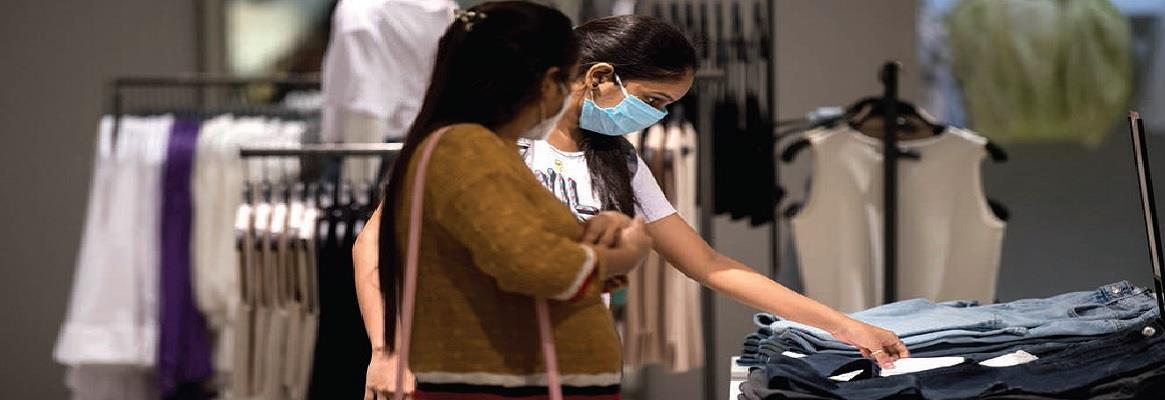Indian fashion retailers are leveraging technology and redefining strategy to cope with the new normal.
Ever since covid-19 has become a reality, most economic sectors around the globe have experienced much uncertainty as the world grappled to understand the disease. The retail industry, especially in India, is among the worst hit and faces multi-pronged challenges, affecting livelihood and economy.
In 2019, the Indian retail industry shared 10 per cent of the country's gross domestic product (GDP), engaging around 8 per cent of the workforce with employment. The Indian retail industry is the fifth largest in the world, ranking 63rd in the ease of doing business ranking and 73rd in the United Nations conference on business-to-consumer trade and development in 2019.
During the initial phase of the pandemic in India, malls, markets and shopping complexes were among the first to be closed, much before the lockdown was announced. Although the demand for essential products rose, fashion retail slumped in a big way.
During the first few phases of the lockdown, the fashion retail industry missed the best sales period for the non-discounted new arrivals. The pandemic and subsequent lockdown derailed the sector by disrupting supply chain and halting manufacturing. Migration of labour and fall in demand added to the woes. Estimates by the Confederation of All India Traders (CAIT) show the retail sector lost over ₹5 lakh crore by May and ₹15 lakh crore by mid-July .
While the fourth phase of unlocking has already started, problems continue to ail the fashion retail segment, as many states are implementing lockdowns in the entire state or at the district levels, causing further disruptions to the supply chain. Owing to the emerging challenges, major brands across the industry are leveraging technology and redefining strategy.

Postponing end-of-season sales: It is largely assumed that fashion retail is not perishable; however, the reality is that it definitely is. Clothes and other products may last for years. However, fashion is evolving every season. In fashion terms, what's brand new this year gets old by the next. While the season's peak is lost for the retailers, the end-of-season sales for the year has been by and large postponed by many brands to between August and October to leverage the festive season and create more scope for the existing inventory to sell.
Measured discount strategies: Brands go for heavy discounts to push sales by volume, thereby increasing the profits even on thin margin. However, given the low demand due to job losses, pay cuts and reverse migration this year, the heavy discount may not just be effective in pushing sales. Consequently, brands are offering measured discounts to maximise the value on sales.
Launches: Despite the pandemic, various brands have followed their planned launches, including new clothing lines or new stores, keeping the market high and active.
Automating supply chain: Leveraging various technologies is the ultimate step initiated by brands. This is being done to meet a number of objectives. The supply chain process is being rebooted and strengthened by adopting technology and integrating various processes therein. Technology is being used to understand the consumer journey and at which stage they exist. Technology adoption also helps brands gain better visibility and data insights, which help them understand the consumer journey better.
Omni-channel approach: The physical store has not lost its position in India, even for the fashion industry; these are still the major money drivers. It is essential for the average Indian customer to experience the apparel he is going to buy. This behavioural change has been fast-tracked by Covid-19. The ecommerce retail segment which adds up to five per cent of total retail and shares 48 per cent of electronics and 29 per cent of apparels has grown in the Covid-19 era. As a result, many companies are increasingly going ahead with omnichannel retailing, delivering the consumers a unified experience via an ecommerce system integrated with physical marketplace, driving online and offline. The industry is receiving a positive response from various D2C avenues, hyper-local initiatives, and retail sales.
Enhancing the customer experience: During crisis, it is important to remain connected to your loved ones, and the same applies to one's customers as well. Through various measures like confidence building communication, informing customers about safety protocols adopted at stores and alerting them of discounts, the industry is trying to deliver its best.
The average consumer is reluctant to come out as freely as before, and that is understandable during a pandemic. The general belief that covid-19 can be defeated by only staying at home is not completely true. This is because over the past few months many more countries with higher population densities have better managed the spread of the infection. We need to emulate such examples in India so that we work and live in a safer environment together. This will also enable the industry to run smoothly and create space for economy and employment to revive.
This article was first published in the October 2020 edition of the print magazine.








Comments